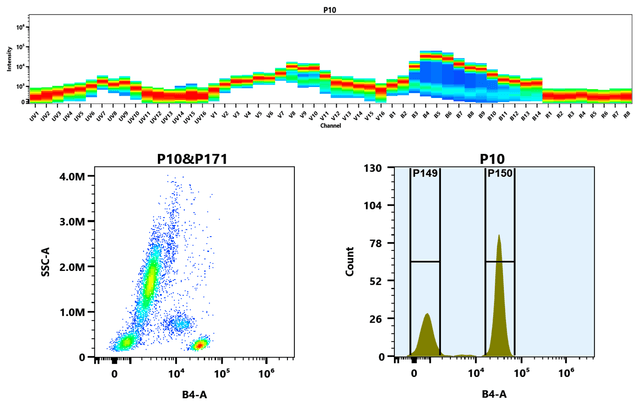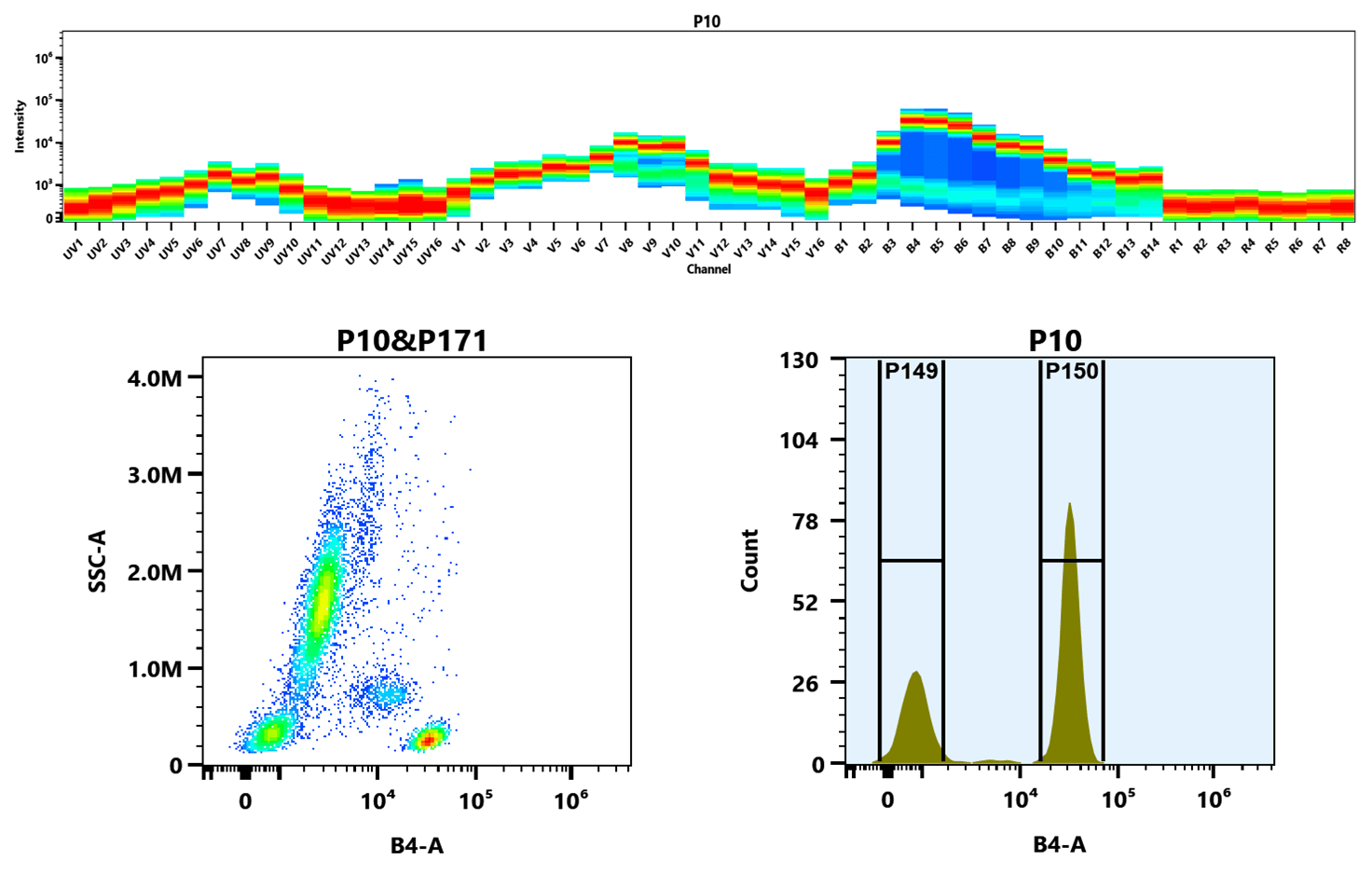mFluor™ Blue 585 SE
| Price | |
| Catalog Number | |
| Unit Size | |
| Quantity |
| Telephone | 1-800-990-8053 |
| Fax | 1-800-609-2943 |
| sales@aatbio.com | |
| International | See distributors |
| Bulk request | Inquire |
| Custom size | Inquire |
| Shipping | Standard overnight for United States, inquire for international |
| Molecular weight | 835.92 |
| Solvent | DMSO |
| Extinction coefficient (cm -1 M -1) | 450001 |
| Excitation (nm) | 491 |
| Emission (nm) | 578 |
| Certificate of Origin | Download PDF |
| H-phrase | H303, H313, H333 |
| Hazard symbol | XN |
| Intended use | Research Use Only (RUO) |
| R-phrase | R20, R21, R22 |
| Storage | Freeze (< -15 °C); Minimize light exposure |
| Overview |
Molecular weight 835.92 | Extinction coefficient (cm -1 M -1) 450001 | Excitation (nm) 491 | Emission (nm) 578 |
Example protocol
PREPARATION OF STOCK SOLUTIONS
Unless otherwise noted, all unused stock solutions should be divided into single-use aliquots and stored at -20 °C after preparation. Avoid repeated freeze-thaw cycles
Mix 100 µL of a reaction buffer (e.g., 1 M sodium carbonate solution or 1 M phosphate buffer with pH ~9.0) with 900 µL of the target protein solution (e.g. antibody, protein concentration >2 mg/mL if possible) to give 1 mL protein labeling stock solution.
Note: The pH of the protein solution (Solution A) should be 8.5 ± 0.5. If the pH of the protein solution is lower than 8.0, adjust the pH to the range of 8.0-9.0 using 1 M sodium bicarbonate solution or 1 M pH 9.0 phosphate buffer.
Note: The protein should be dissolved in 1X phosphate buffered saline (PBS), pH 7.2-7.4. If the protein is dissolved in Tris or glycine buffer, it must be dialyzed against 1X PBS, pH 7.2-7.4, to remove free amines or ammonium salts (such as ammonium sulfate and ammonium acetate) that are widely used for protein precipitation.
Note: Impure antibodies or antibodies stabilized with bovine serum albumin (BSA) or gelatin will not be labeled well. The presence of sodium azide or thimerosal might also interfere with the conjugation reaction. Sodium azide or thimerosal can be removed by dialysis or spin column for optimal labeling results.
Note: The conjugation efficiency is significantly reduced if the protein concentration is less than 2 mg/mL. For optimal labeling efficiency the final protein concentration range of 2-10 mg/mL is recommended.
Add anhydrous DMSO into the vial of mFluor™ Blue 585 SE to make a 10 mM stock solution. Mix well by pipetting or vortex.
Note: Prepare the dye stock solution (Solution B) before starting the conjugation. Use promptly. Extended storage of the dye stock solution may reduce the dye activity. Solution B can be stored in freezer for two weeks when kept from light and moisture. Avoid freeze-thaw cycles.
SAMPLE EXPERIMENTAL PROTOCOL
This labeling protocol was developed for the conjugate of Goat anti-mouse IgG with mFluor™ Blue 585 SE. You might need further optimization for your particular proteins.
Note: Each protein requires a distinct dye/protein ratio, which also depends on the properties of dyes. Over-labeling of a protein could detrimentally affect its binding affinity while the protein conjugates of low dye/protein ratio give reduced sensitivity.
Use a 10:1 molar ratio of Solution B (dye)/Solution A (protein) as the starting point: Add 5 µL of the dye stock solution (Solution B, assuming the dye stock solution is 10 mM) into the vial of the protein solution (95 µL of Solution A) with effective shaking. The concentration of the protein is ~0.05 mM assuming the protein concentration is 10 mg/mL and the molecular weight of the protein is ~200KD.
Note: We recommend using a 10:1 molar ratio of Solution B (dye)/Solution A (protein). If it is too low or too high, determine the optimal dye/protein ratio at 5:1, 15:1, and 20:1 respectively.
- Continue to rotate or shake the reaction mixture at room temperature for 30-60 minutes.
The following protocol is an example of dye-protein conjugate purification by using a Sephadex G-25 column.
- Prepare Sephadex G-25 column according to the manufacture instruction.
- Load the reaction mixture (From "Run conjugation reaction") to the top of the Sephadex G-25 column.
- Add PBS (pH 7.2-7.4) as soon as the sample runs just below the top resin surface.
Add more PBS (pH 7.2-7.4) to the desired sample to complete the column purification. Combine the fractions that contain the desired dye-protein conjugate.
Note: For immediate use, the dye-protein conjugate needs to be diluted with staining buffer, and aliquoted for multiple uses.
Note: For longer-term storage, the dye-protein conjugate solution needs to be concentrated or freeze-dried.
Calculators
Common stock solution preparation
| 0.1 mg | 0.5 mg | 1 mg | 5 mg | 10 mg | |
| 1 mM | 119.629 µL | 598.143 µL | 1.196 mL | 5.981 mL | 11.963 mL |
| 5 mM | 23.926 µL | 119.629 µL | 239.257 µL | 1.196 mL | 2.393 mL |
| 10 mM | 11.963 µL | 59.814 µL | 119.629 µL | 598.143 µL | 1.196 mL |
Molarity calculator
| Mass (Calculate) | Molecular weight | Volume (Calculate) | Concentration (Calculate) | Moles | ||||
| / | = | x | = |
Spectrum

Spectral properties
| Extinction coefficient (cm -1 M -1) | 450001 |
| Excitation (nm) | 491 |
| Emission (nm) | 578 |
Product Family
| Name | Excitation (nm) | Emission (nm) | Extinction coefficient (cm -1 M -1) | Correction Factor (260 nm) | Correction Factor (280 nm) |
| mFluor™ Blue 570 SE | 553 | 565 | 1200001 | 0.228 | 0.179 |
| mFluor™ Blue 630 SE | 470 | 632 | 490001 | 0.197 | 0.275 |
| mFluor™ Blue 660 SE | 481 | 663 | 260001 | 0.338 | 0.32 |
| mFluor™ Blue 580 SE | 485 | 580 | 400001 | 0.363 | 0.247 |
| mFluor™ Blue 590 SE | 569 | 589 | 810001 | 0.671 | 0.406 |
| mFluor™ Blue 620 SE | 589 | 616 | 980001 | 0.683 | 0.849 |
| mFluor™ Blue 583 SE | 498 | 585 | 450001 | 1.17 | 0.35 |
| mFluor™ Blue 615 SE | 510 | 615 | 400001 | - | - |
Images
References
Authors: Genkel, Vadim and Dolgushin, Ilya and Baturina, Irina and Savochkina, Albina and Kuznetsova, Alla and Pykhova, Lubov and Shaposhnik, Igor
Journal: International journal of inflammation (2021): 6695468
Authors: Flores-Montero, Juan and Kalina, Tomas and Corral-Mateos, Alba and Sanoja-Flores, Luzalba and Pérez-Andrés, Martin and Martin-Ayuso, Marta and Sedek, Lukasz and Rejlova, Katerina and Mayado, Andrea and Fernández, Paula and van der Velden, Vincent and Bottcher, Sebastian and van Dongen, Jaques J M and Orfao, Alberto
Journal: Journal of immunological methods (2019): 112618
Authors: De Vita, Martina and Catzola, Valentina and Buzzonetti, Alexia and Fossati, Marco and Battaglia, Alessandra and Zamai, Loris and Fattorossi, Andrea
Journal: Cytometry. Part B, Clinical cytometry (2015): 352-4
Authors: De Vita, Martina and Catzola, Valentina and Buzzonetti, Alexia and Fossati, Marco and Battaglia, Alessandra and Zamai, Loris and Fattorossi, Andrea
Journal: Cytometry. Part B, Clinical cytometry (2014)


